
Measuring your waist to hip ratio at home is another simple and inexpensive way to evaluate your risk for multiple diseases associated with obesity such as heart disease, diabetes, high blood pressure, high cholesterol, stroke, sleep apnea, cancer as well as all-cause mortality.
This measurement may be more useful than just the BMI because it is measuring the excess weight around the midsection. This type of obesity, known as abdominal obesity, has been linked to higher risk for disease. Many people can have a normal BMI but carry a large amount of weight around their mid-section.
WHO Risk Classification
Low Risk- Women <0.8, Men <0.95
Moderate Risk- Women 0.81-0.85, Men 0.96-1.0
High Risk- Women >0.86, Men >1.0
How to measure your waist to hip ratio:
- Stand up straight and exhale.
- Use a flexible measuring tape.
- Waist Circumference is measured at the level of the smallest part of your waist- just above your belly button.
- Hip Circumference is measured at the widest part of your buttocks.
- Divide your waist circumference by your hip circumference.
If you find your number to be in the high or moderate risk category discuss your findings with your health care provider.
This article is for information purposes only and is not medical advice. Consult with your medical provider prior to any lab testing, diet changes, new supplement/medication and all other medical associated topics/conditions.
Do you live in TX, CA, GA, NC or OH? Looking to improve your health through culinary medicine? Message me for information about my consultation services. @neversayneverwellness@gmail.com
References:
https://www.healthline.com/health/waist-to-hip-ratio
https://www.webmd.com/fitness-exercise/what-is-waist-to-hip-ratio
